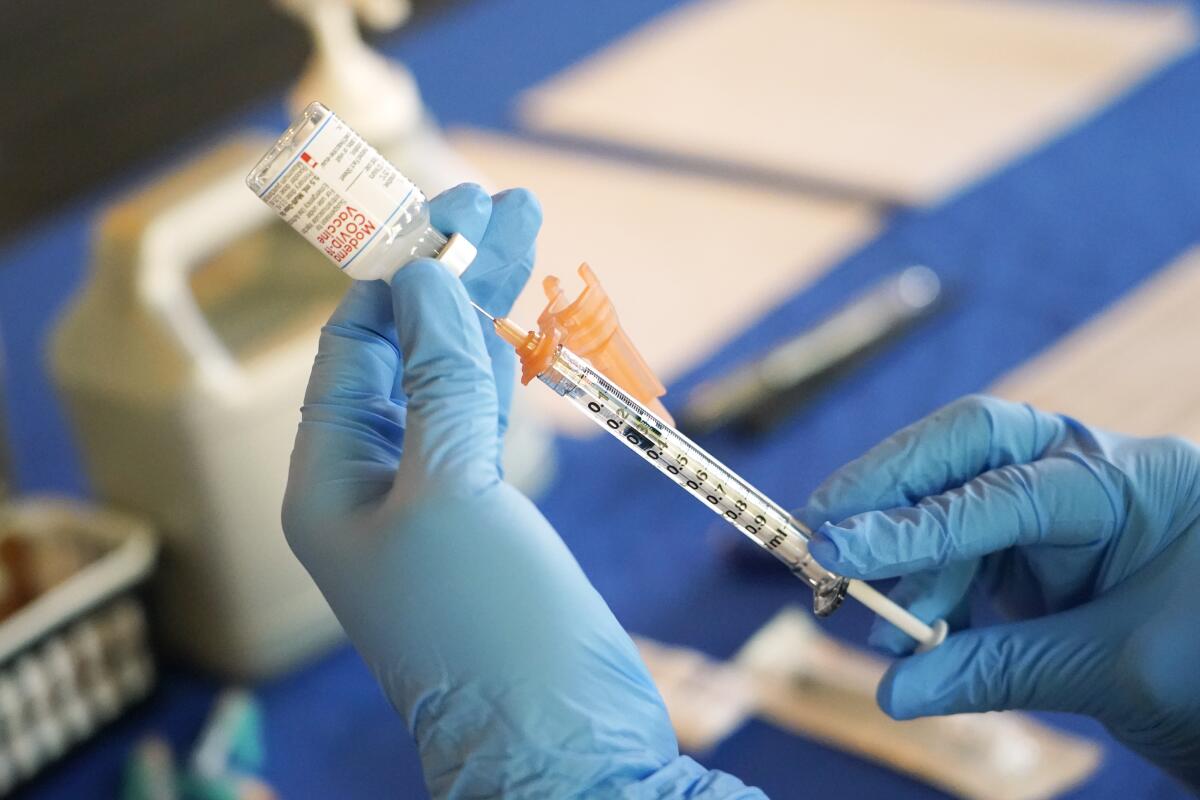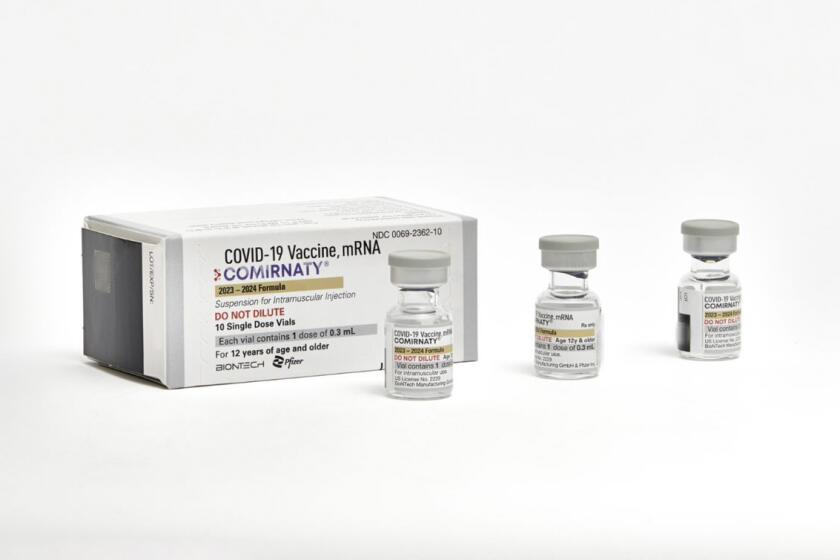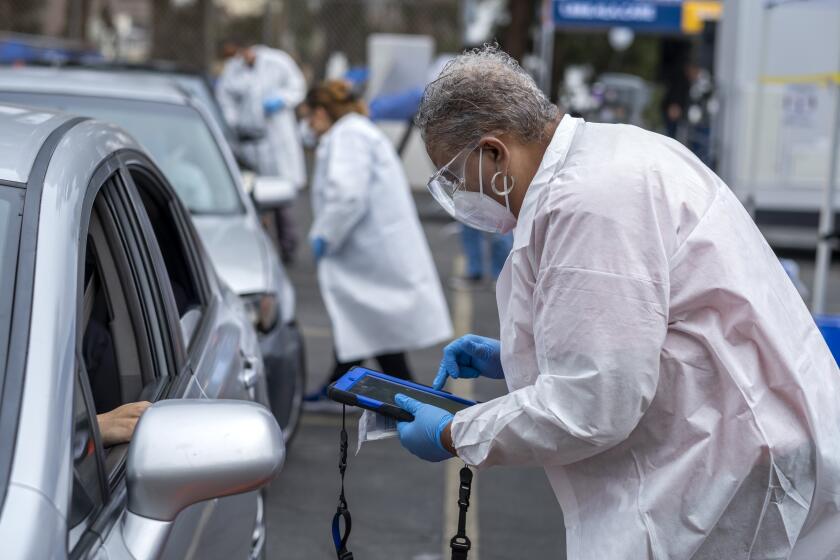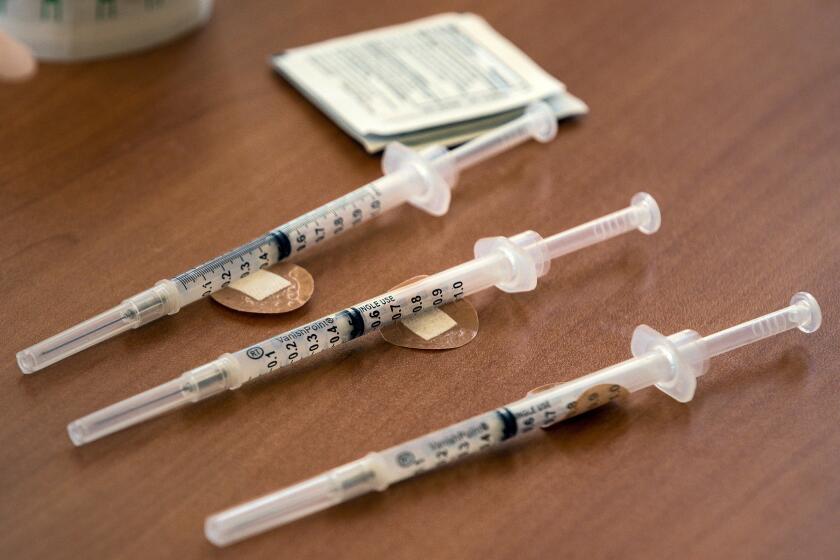Should you get the new COVID booster? The CDC is about to decide

- Share via
A small percentage of Americans got the most recent COVID-19 booster shot, and even fewer probably realize the federal government is preparing to recommend yet another shot as early as Tuesday.
Until a week or two ago, Dr. William Schaffner read that indifference as a sign the Centers for Disease Control and Prevention should advocate vaccinating only those most at risk from the virus.
But then Schaffner, an infectious-disease specialist at Vanderbilt University Medical Center, changed his mind.
Members of the CDC’s Advisory Committee on Immunization Practices won him over to the argument that the vaccine be recommended for all Americans above 6 months of age, he said in an interview. The committee, which sets U.S. vaccination policy and helps determine insurance coverage for vaccines, will vote on the question Tuesday after it weighs the benefits of updated vaccines from Pfizer and Moderna. The U.S. Food and Drug Administration approved booster shots from the two companies on Monday.
U.S. regulators have approved updated COVID-19 vaccines from Pfizer and Moderna, which are aimed at revving up protection this fall and winter.
Not all vaccine experts see it quite as Schaffner, a nonvoting liaison representative to the ACIP, does.
“I don’t plan to get it myself,” said Dr. Paul Offit, the director of the Vaccine Education Center at Children’s Hospital of Philadelphia. He’s had two boosters and got COVID-19 last year. Another vaccine might increase his protection against mild infection for a few months, but like most Americans’ immune systems, his is already familiar enough with the virus to protect him from serious disease, Offit believes.
Some of Schaffner’s scientific colleagues argue the government should be recommending the shot only for frail, older, sick and immunocompromised people. Over 95% of the U.S. population has some immunity to COVID-19 through vaccination, infection or both, and the risks of serious illness for healthy younger people are not great.
Schaffner doesn’t disagree. But lots of not-necessarily-vulnerable Americans do want the shot for themselves and their children, and, without a CDC recommendation, insurance companies wouldn’t have to pay for the vaccine.
An occasional series of stories about the transition out of the COVID-19 pandemic and how life in the U.S. will be changed in its wake.
It’s “pretty awful” that Pfizer and Moderna, the two main COVID-19 vaccine producers, have decided to charge up to $130 a shot, compared with $30 last year for the booster, which was produced under government contract, said Dr. Kathryn Edwards, a professor of pediatrics at Vanderbilt and a member of an ACIP working group on COVID-19. (Pfizer spokesperson Amy Rose said the price was “consistent with the value delivered” and reflected higher expenses to provide the shots commercially.)
But a partial recommendation could leave the very groups who suffered most during the pandemic — minorities and other disadvantaged groups — unable to get vaccinated if they want but can’t afford to.
“The last thing we need are financial barriers that would enhance disparities,” Schaffner said.
A 1993 law requires the federal government to pay for childhood vaccines recommended by the ACIP, and more recent legislation requires coverage of adult vaccines within 15 days of an ACIP recommendation.
Pfizer and Moderna continue to make billions of dollars in sales of COVID-19 vaccines, although they are producing fewer doses. Moderna CEO Stéphane Bancel told investors in August that the company expected its global COVID-19 vaccine sales to be $6 billion to $8 billion this year, depending on uptake in the U.S. Pfizer expects about $14 billion this year.
Within a few years, both companies expect to be producing combination vaccines protecting against influenza, COVID-19 and possibly respiratory syncytial virus, or RSV. About 170 million flu vaccines were distributed last flu season in the U.S., so a combination product could lock in a large market for COVID-19 vaccines as well.
Moderna and Pfizer have announced plans to quadruple the price of their COVID vaccines, putting them out of reach for millions. The U.S. should step in.
Despite broad recommendations for the updated COVID-19 booster shot released last fall, only 17% of the U.S. population got it, including about 43% of those over 65. How many will get the vaccine this season is uncertain, as is the benefit of the shot.
For the record:
3:39 p.m. Sept. 11, 2023A previous version of this article said the new Moderna vaccine was compared with the formulation released last year. It was actually compared with a different bivalent formulation that targeted XBB.1.5 and the BA.4/BA.5 subvariants.
A preliminary study of the new Moderna vaccine showed that it increased antibodies to various coronavirus strains, though it wasn’t clear how much protection it would offer, nor for how long.
Christopher Ridley, a Moderna spokesperson, said the updated vaccine was well matched to current viral strains.
But John Moore, a professor of microbiology and immunology at Weill Cornell Medical College, said the new vaccine is unlikely to be “a game changer.”
For healthier adults and children, “it’s a boost in protection for a few months,” Moore said. Who exactly will benefit most is impossible to predict because the U.S. is “not a cookie-cutter population.” Its people have by now been exposed to a bewildering combination of vaccines, boosters and different strains of the virus.
Fearmongering has distorted the threat of the virus, Moore said. He is skeptical of the significance of the recent uptick in COVID-19 hospitalizations, and criticized social media posters who have raised fears about new viral strains that don’t seem to pose any fundamental challenge to the new vaccines.
“Editorial FOMO drove summer surge worries,” Moore said, using an acronym for “fear of missing out.” Despite worrying comments and tweets by physicians such as Dr. Eric Topol, director of the Scripps Research Translational Institute, about a new coronavirus variant called BA.2.86, “it turned out to be a real nothingburger,” Moore said.
Los Angeles County officials said they have no plans for new public mask mandates — a sign of how COVID-19 policies have changed in the back-to-normal era.
Even Dr. Ashish Jha, who coordinated the Biden administration’s COVID-19 response before returning to his post as dean of the Brown University School of Public Health this year, agrees there is some ambiguity in the issue. While he recommends that 20-year-olds get the booster, “a reasonable person” could disagree.
Unfortunately, such discussions in the current environment are clouded by “nonsense and bad information” that causes confusion and hurts people, he said in a recent podcast interview.
Whether truly needed or not, the vaccines, proponents say, are safe enough that even the small benefit of taking them will outweigh the risks. The major, though rare, serious side effect of the Pfizer and Moderna vaccines — myocarditis, which particularly affected men in their teens and 20s — appears mainly to have occurred during the first two-shot series.
Paradoxically, those who most need protection from COVID-19 are often likely to have weakened immune systems that fail to generate the hoped-for response to vaccination.
When everyone around them stops taking pandemic precautions, it gets harder for immunocompromised Americans to protect themselves against COVID.
So the vaccine is arguably most relevant for healthy people who come in frequent contact with vulnerable individuals. With that in mind, England has announced the new booster would be offered only to people who are 65 or older, in nursing homes, or immunologically vulnerable — or who work or live with members of those groups.
“Any efforts to promote the new boosters should focus squarely on those at high risk,” said Dr. Norman Hearst, a family physician in San Francisco. While recommending the vaccine for older patients, he said he wouldn’t advise a booster for young males because of the rare risk of myocarditis and the negligible benefit. “The question is all the other people in between.”
In a commentary last November, Dr. Shira Doron and Dr. Monica Gandhi said vaccination campaigns should be radically honest about the limited value of vaccines for long-term protection against infection. Such a campaign might advocate vaccinating children because even though it won’t protect durably, “it might prevent the rare case of severe disease,” the infectious disease doctors wrote.
This article was produced by KFF Health News, which publishes California Healthline, an editorially independent service of the California Health Care Foundation.











